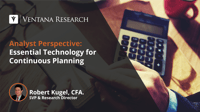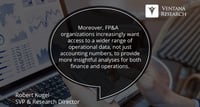As a result of the rapidly changing business landscape in 2020 and the need to quickly – and intelligently – change business plans and budgets, many more companies have been deciding to adopt a continuous planning approach to be able to add speed and flexibility. Transforming how organizations plan and budget has become a top-of-mind issue for CFO and even CEOs. Ventana Research has been advocating what we call continuous planning to improve organizational performance. In this multimedia...
Read More
Topics:
FP&A,
Office of Finance,
budget,
CFO,
financial planning
The use of blockchain distributed ledgers in business processes is now a common theme in many business software vendors’ presentations. The technology has a multitude of potential uses. However, presentations about the opportunities for digital transformation always leave me wondering: How is this magic going to happen? I wonder this because the details about how data flows from point A to point B via a blockchain are critically important to blockchain utility and therefore the pace of its...
Read More
Topics:
Planning,
Predictive Analytics,
Forecast,
FP&A,
Machine Learning,
Reporting,
budget,
Budgeting,
Continuous Planning,
Analytics,
Data Management,
Cognitive Computing,
Integrated Business Planning,
AI,
forecasting,
consolidating
Ventana Research uses the term “predictive finance” to describe a forward-looking, action-oriented finance organization that places emphasis on advising its company rather than fulfilling the traditional roles of a transactions processor and reporter. Technology is driving the shift away from the traditional bean-counting role. The cumulative evolution of software advances will substantially reduce finance and accounting workloads by automating most of the mechanical, rote functions in...
Read More
Topics:
Planning,
Predictive Analytics,
Forecast,
FP&A,
Machine Learning,
Reporting,
budget,
Budgeting,
Continuous Planning,
Analytics,
Data Management,
Cognitive Computing,
Integrated Business Planning,
AI,
forecasting,
consolidating
Read More
Topics:
Planning,
SAP,
Forecast,
Office of Finance,
Operational Performance Management (OPM),
budget,
Budgeting,
XBRL,
Business Analytics,
Business Intelligence,
Business Mobility,
Governance, Risk & Compliance (GRC),
Business Performance Management (BPM),
CFO,
Financial Performance Management (FPM),
Information Management (IM),
Supply Chain Performance Management (SCPM),
agile,
budgeting software,
CEO,
Corporate Finance,
Financial Performance Management,
Integrated Business Planning
Alight Planning sells planning and budgeting software mainly to midsize companies and stresses its software’s ability to support a more effective approach to corporate planning and budgeting. It calls this “agile planning,” a term used to contrast a traditional, highly deterministic method of drawing up and executing plans with an “agile” mindset that is better able to deal with the high level of economic volatility that most businesses confront today. In many respects Alight’s approach is...
Read More
Topics:
Planning,
Forecast,
Office of Finance,
Operational Performance Management (OPM),
budget,
Budgeting,
CFO,
Financial Performance Management (FPM),
Sales Performance Management (SPM),
Supply Chain Performance Management (SCPM),
agile,
budgeting software,
CEO,
Integrated Business Planning













